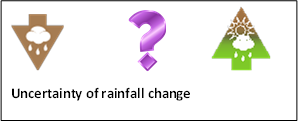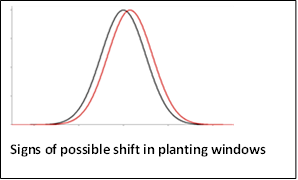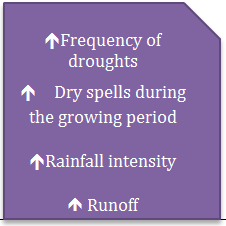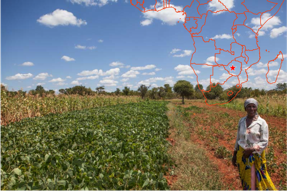How will climate variability and change impact on family farming in semi-arid Zimbabwe?


Fig. 1. Effects of climate change
Unless government and financial partners create a favorable environment for investments towards substantial improvements in farming practices and market oriented support systems, climate change means greater food insecurity for large parts of the population.


Fig. 2. Shifts in planting windows Fig. 3. Effects of climate change
How do projected climate variability and change affect crops and livestock?
Temperature in Nkayi will increase by 2-3'C. Already temperatures are higher than for optimal growth of the common crops, long term maximum and minimum average 26.9'C and 13.4'C respectively.
Projections for rainfall are uncertain. However, low and highly variable rainfall will be a risk for agricultural production. With a later start of the rains, there can be years of very high and years with very low rainfall. Planting windows may shorten and/or shift to a later period.
read more >>Why is this important?
Mixed crop livestock farming is the predominant form of land use and supplier of food and livelihoods. Production levels are currently extremely low, and severely affected by variable and changing climate. Unpredictability of seasonal climate has become a major issue for smallholder farming.
Reducing the risk from climate vagaries in the context of diversification and integration of crops and livestock, can have huge opportunities for impact in Zimbabwe.
read more >>How did we obtain these results?
Climate change projections were generated comparing current with mid-century climate scenarios (2040-2070). For the simulations we used quality controlled climate data (1980-2010), based on historical daily weather records (1980-2002), filled with bias corrected AgMERRA data sets. Climate scenarios of 19 General Circulation Models (GCMs) were applied for the Representative Concentration Pathway with highest emisssions (RCP8.5 (CMIP5)) and two time periods of 31 years each (control: 1980-2010; mid-century: 2040-2070).
Discussions with farmers in Nkayi and provincial level agricultural extension services added information on observed changes in critical climate indicators and implications for planning and management of farming activities.
Can the results be generalized?
The pattern of climate variability and change apply for large parts of semi-arid Southern Africa, where mixed crop livestock farming is the predominant form of livelihoods.
Improved management and climate change adaptation strategies must be co-designed by stakeholders within areas of similar agro-ecological conditions and adjusted over time, to also capture other important drivers and market opportunities.

Fig. 4. Photograph: Swathi Sridharan
